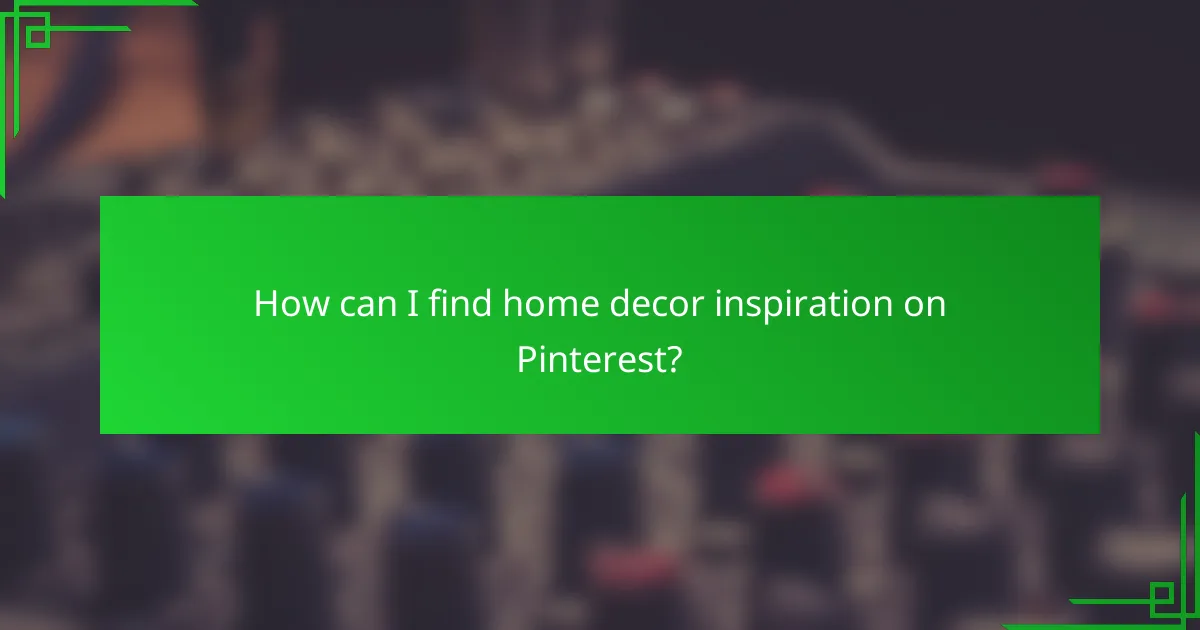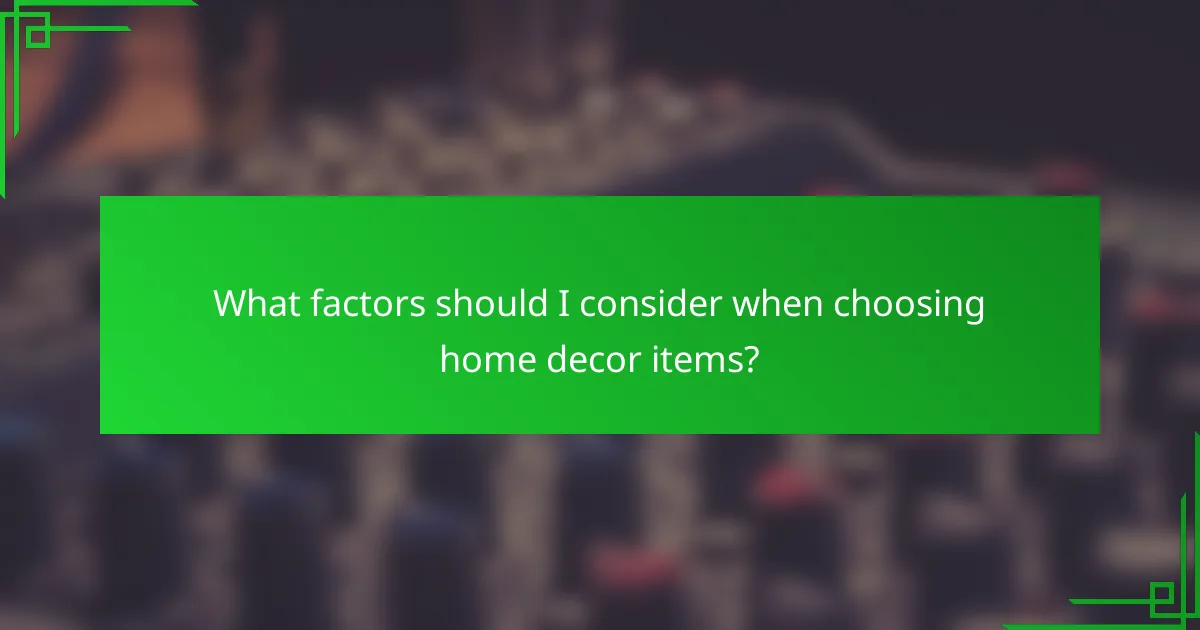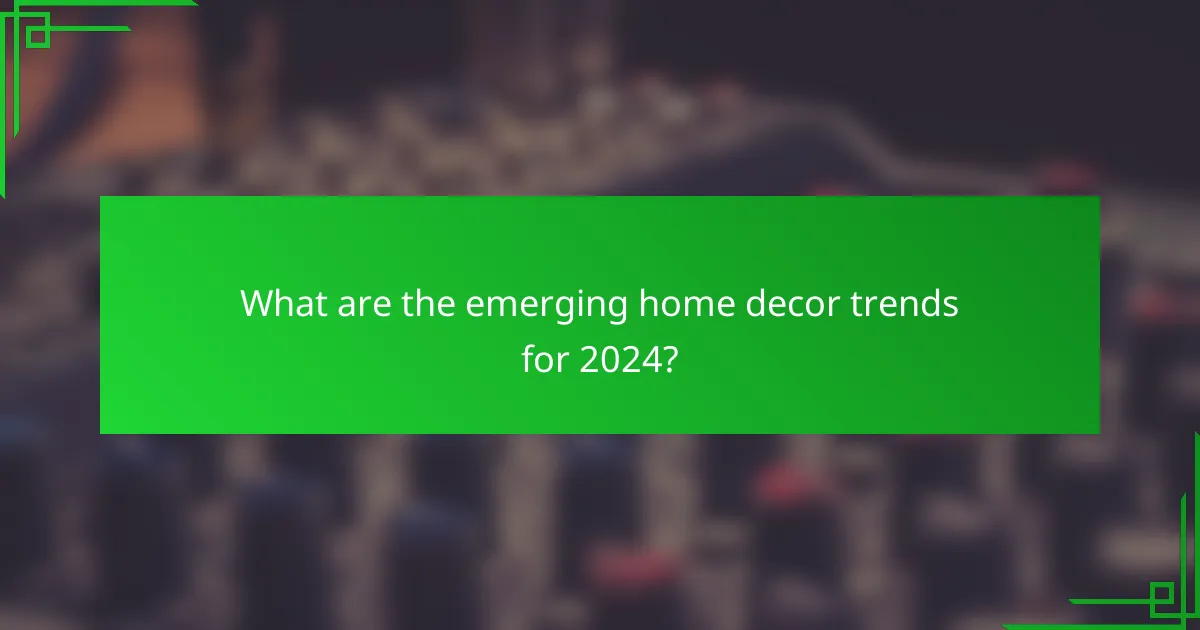Social media has become a pivotal force in shaping home decor trends, allowing users to find inspiration and innovative designs at their fingertips. Platforms like Instagram and Pinterest showcase a diverse array of styles, from maximalism to biophilic design, enabling individuals to express their unique tastes and enhance their living spaces. As influencers share their creative visions, the influence of viral content continues to redefine how we approach home decor.

How is social media shaping home decor trends in the US?
Social media is significantly influencing home decor trends in the US by providing a platform for inspiration and showcasing innovative designs. Users can easily discover and adopt new styles, often driven by influencers and viral content.
Influencer collaborations
Influencer collaborations play a crucial role in shaping home decor trends. Brands partner with popular figures to create curated collections that resonate with their followers, making it easier for consumers to access trendy products. For example, a well-known influencer might launch a line of home accessories that reflect their unique style, encouraging fans to replicate the look in their own homes.
When considering influencer collaborations, it’s essential to evaluate the authenticity and alignment of the influencer’s style with your brand. This ensures that the products resonate with the target audience and maintain credibility.
Visual platforms driving trends
Visual platforms like Instagram and Pinterest are key drivers of home decor trends. These platforms allow users to share images and videos of their spaces, creating a rich tapestry of ideas that others can draw inspiration from. Hashtags and trending topics can quickly elevate certain styles, making them popular almost overnight.
To leverage these platforms effectively, brands should focus on high-quality visuals and engaging content that encourages sharing. Regularly updating content and participating in trending challenges can help maintain visibility and relevance in the fast-paced social media landscape.
User-generated content impact
User-generated content (UGC) has a profound impact on home decor trends, as it showcases real-life applications of products and styles. When customers share their own decor projects, it builds a sense of community and trust, encouraging others to try similar designs. UGC can also highlight diverse interpretations of trends, making them more accessible to a wider audience.
Brands can enhance their presence by encouraging customers to share their decor experiences through contests or dedicated hashtags. This not only increases engagement but also provides a wealth of authentic content that can be repurposed for marketing efforts.

What are the current home decor trends popular on Instagram?
Current home decor trends on Instagram highlight a blend of styles that reflect personal expression and comfort. Popular themes include maximalism, biophilic design, and vintage aesthetics, each offering unique ways to enhance living spaces.
Maximalism vs Minimalism
Maximalism embraces bold colors, eclectic patterns, and an abundance of decor, encouraging a personalized and layered look. In contrast, minimalism focuses on simplicity, clean lines, and a neutral palette, promoting a sense of calm and spaciousness.
When choosing between these styles, consider your lifestyle and preferences. Maximalism can create a vibrant atmosphere but may require more maintenance, while minimalism often leads to easier upkeep and a more streamlined environment.
Biophilic design elements
Biophilic design incorporates natural elements into home decor, aiming to connect indoor spaces with the outdoors. This can include the use of plants, natural materials, and ample natural light to create a refreshing and calming atmosphere.
To implement biophilic design, consider adding indoor plants, using wood or stone finishes, and maximizing window space. This trend not only enhances aesthetics but also promotes well-being by improving air quality and reducing stress.
Vintage and retro styles
Vintage and retro styles draw inspiration from past decades, often featuring unique furniture pieces and nostalgic color palettes. This trend allows homeowners to mix old and new elements, creating a distinctive and personalized space.
To incorporate vintage decor, visit thrift stores or flea markets for one-of-a-kind finds. Pairing vintage items with contemporary pieces can create a balanced look that feels both timeless and modern.

How can I find home decor inspiration on Pinterest?
Pinterest is a powerful platform for discovering home decor inspiration, offering a vast array of images and ideas tailored to your style preferences. By searching for specific keywords or browsing curated boards, you can easily gather concepts that resonate with your vision for your space.
Curated boards for specific styles
Curated boards on Pinterest allow users to explore home decor styles such as bohemian, minimalist, or industrial. These boards compile images and ideas that reflect a particular aesthetic, making it easier to visualize how different elements can come together in your home.
To find these boards, use the search function with style-specific terms like “modern farmhouse” or “Scandinavian decor.” You can also follow popular home decor accounts that regularly update their boards with fresh content.
Trending color palettes
Color palettes play a crucial role in home decor, and Pinterest showcases current trends that can inspire your choices. Popular palettes often include combinations of neutral tones, bold accents, or seasonal colors that reflect the latest design movements.
When selecting a color palette, consider how the colors will interact with your existing furnishings and the overall mood you want to create. Look for pins that highlight color combinations and use them as a guide for your own projects.
DIY project ideas
Pinterest is rich with DIY project ideas that can help you personalize your home decor. From upcycling furniture to creating custom wall art, these projects often come with step-by-step instructions and materials lists.
To get started, search for DIY projects that match your skill level and available materials. Focus on ideas that not only enhance your decor but also fit within your budget, allowing you to create a unique space without overspending.

What are the best e-commerce platforms for home decor?
The best e-commerce platforms for home decor offer a mix of variety, modern design, and convenience. Depending on your needs, you can choose platforms that specialize in a wide range of products, contemporary styles, or quick and easy shopping experiences.
Wayfair for variety
Wayfair is known for its extensive selection of home decor items, featuring millions of products across various styles and price points. This platform allows users to filter searches by category, style, and price, making it easy to find exactly what you need.
When shopping on Wayfair, consider checking customer reviews and ratings to gauge product quality. Additionally, take advantage of seasonal sales and promotions, which can offer significant savings on larger purchases.
West Elm for modern design
West Elm specializes in modern and contemporary home decor, focusing on stylish furniture and accessories that appeal to design-conscious consumers. Their products often feature sustainable materials and are designed to fit seamlessly into modern living spaces.
For those interested in unique design pieces, West Elm frequently collaborates with local artisans and designers. Keep an eye out for limited-edition collections that can add a distinctive touch to your home.
Amazon for convenience
Amazon is a go-to platform for convenient home decor shopping, offering a vast range of products with quick shipping options. With features like customer reviews, Prime membership benefits, and easy returns, it simplifies the shopping experience.
When using Amazon for home decor, utilize the search filters to narrow down options based on price, brand, and customer ratings. Be mindful of product dimensions and materials to ensure they meet your expectations before making a purchase.

What factors should I consider when choosing home decor items?
When selecting home decor items, consider how well they fit with your existing style, their quality and longevity, and your budget. These factors will help ensure that your choices enhance your living space without causing financial strain or mismatched aesthetics.
Compatibility with existing decor
Ensure that new decor items complement your current furnishings and color palette. For instance, if your home features a modern aesthetic, opt for sleek lines and minimalistic designs rather than ornate or vintage pieces.
A good rule of thumb is to maintain a consistent color scheme or style throughout your space. If you’re unsure, consider creating a mood board to visualize how new items will integrate with your existing decor.
Material quality and durability
Assess the quality of materials used in decor items, as this affects both appearance and lifespan. High-quality materials, such as solid wood or metal, tend to last longer and withstand wear and tear better than cheaper alternatives like particle board or plastic.
Look for items with warranties or guarantees, which can indicate a manufacturer’s confidence in their durability. Additionally, consider the maintenance required for different materials; for example, leather may need conditioning, while certain fabrics may require special cleaning.
Price and budget considerations
Establish a clear budget before shopping for home decor to avoid overspending. Prices can vary widely based on brand, material, and design, so setting a range can help narrow your choices effectively.
Consider allocating your budget based on the importance of each item. For instance, invest more in key pieces like a sofa or dining table, while opting for more affordable accessories like cushions or wall art. Look for sales or second-hand options to stretch your budget further.

What are the emerging home decor trends for 2024?
Emerging home decor trends for 2024 emphasize sustainability, personalization, and technology integration. Homeowners are increasingly seeking eco-friendly materials, unique designs that reflect their personalities, and smart home features that enhance convenience.
Sustainable Materials and Eco-Friendly Designs
In 2024, sustainable materials will dominate home decor choices. This includes the use of reclaimed wood, recycled metals, and organic textiles, which not only reduce environmental impact but also add character to spaces.
Consider incorporating plants and biophilic design elements, which promote a connection to nature. This trend encourages the use of indoor gardens, natural light, and earthy color palettes to create calming environments.
Personalization and Unique Aesthetics
Homeowners are moving away from mass-produced items and opting for personalized decor that reflects their individual tastes. Custom furniture, handmade accessories, and unique art pieces are becoming essential in creating a distinctive home atmosphere.
To achieve this, consider sourcing items from local artisans or vintage shops. Mixing different styles, such as modern with bohemian or industrial with rustic, can also enhance the uniqueness of your space.
Smart Home Integration
Smart home technology is increasingly influencing home decor trends. In 2024, integrating smart devices seamlessly into design will be key, allowing for both functionality and aesthetic appeal.
Consider smart lighting, thermostats, and security systems that can be controlled via mobile apps. Choose devices that blend with your decor, such as stylish smart speakers or discreetly installed security cameras, to maintain a cohesive look.
